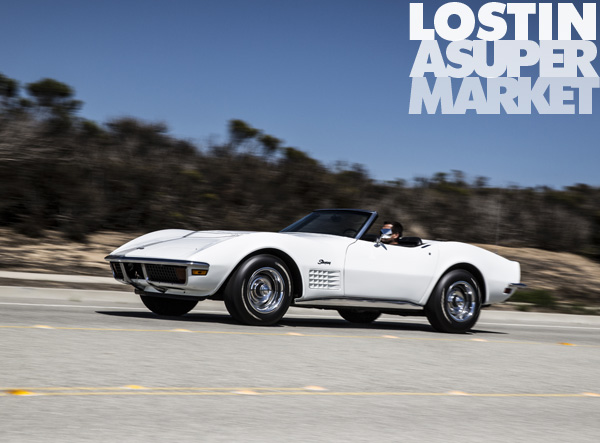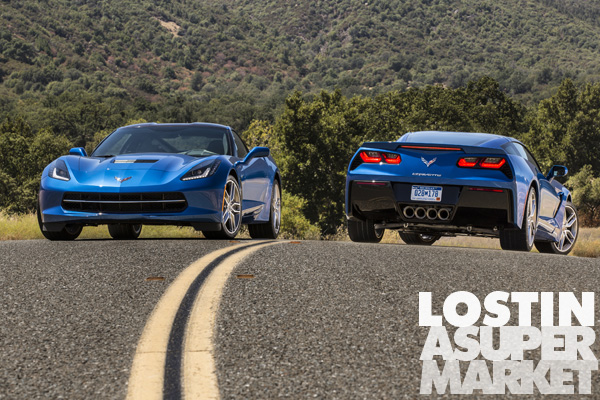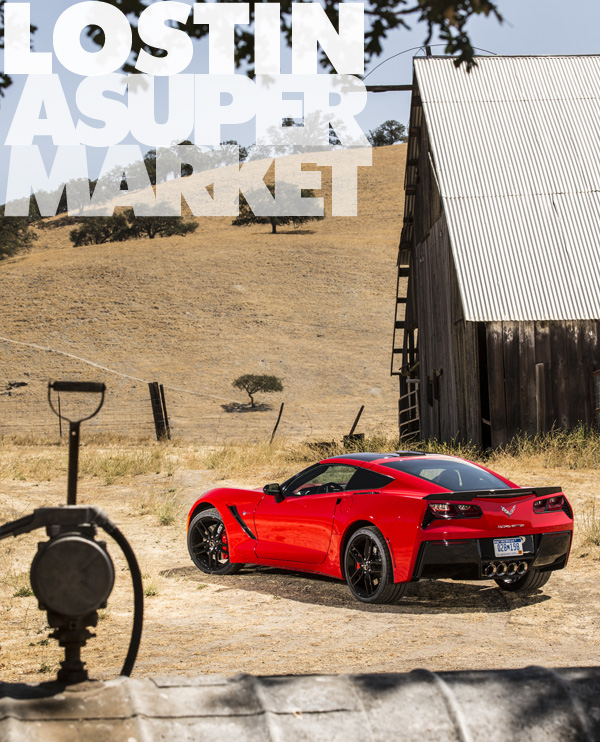It’s like a stepping into a time machine. Marty McFly skipping through the decades, the vehicle of choice not a DeLorean DMC-12 but rather a Corvette — one gleaming white specimen morphing from generation to generation. The concept is genius, and frankly astounding that no other automaker has offered it before: the opportunity to test out a single example of each generation of its flagship sports car, one after the other. From the humble 2-speed, inline-6-cylinder 1953 C1 to the 6-speed, direct-injected V8 C6, we will drive them all.
Then, and only then, will we be granted audience with Chevrolet’s highly hyped, highly anticipated, highly engineered C7 Stingray. On the track.
So when do we start?
Flashing through the generations of Corvette at that private Monterey airport is not only a lesson in the advancement of America’s greatest supercar, but also a Cliff’s Notes history of automotive achievement — a cold splash of reality for anyone who’s never driven a car built before 1970. While the original Vette was a thing of aesthetic glory, and its “Stingray” follow-up one of the most important automotive sequels in history, there is much to be desired from a driver’s standpoint. While steering certainly requires significant arm strength, it is braking that causes the most anxiety; getting either car to stop from even 30 mph is an effort of Fred Flintstone proportions. Thighs quiver from thrusting pedal to bulkhead with every fiber of quadriceps muscle.
Unexpectedly, the leap from C2 to C3 is the biggest disappointment. It is the only generational evolution that sees a dip in power (from 425 horses to 255), and although braking improves the C3 just seems sloppy all around. Blame American arrogance, contemporary Federal emissions requirements or flat-out 70s bohemian insouciance, but the C3 just seems lethargic. And unkempt. Too many Quaaludes, man.
Easily the biggest technological leap we experience comes between the Boogie Nights excess of that coke-nosed C3 and the engineered modernity of the 1984 C4. Not that the C4 is without frill — its interior plucked directly from a Syd Mead daydream, the dash features a sundry of graphic gauges that makes Knight Rider’s interface look realistic. But the C4 is the first generation of Vette that feels like a modern car, from its tight fit and finish to the suite of powered driving aids.
Keep reading our testdrive of the Corvette Stingray after the Jump…
“I consume each turn faster & faster because, dammit, the Vette handles every body blow I throw…”
From the C4 onward the generations grow more powerful, quicker and better built. The C5 and C6 are legitimate supercars in performance: 385 and 436 horsepower respectively, with rear tires fat and asphalt starved. Still, compared to other vehicles in the “supercar” pantheon, they are somewhat lacking — most obviously in interior appointments and overall sophistication. It’s not that the last three Vettes don’t have personality; they all do. They aren’t as aesthetically lost as 1980-90’s Mustangs or Camaros, for instance, and they display an aggressive business-first stance with supercar-worthy profiles. But there has always been something milquetoast about the final product, lacking the drama that made the first three Vette generations iconic shapes in the Global Supercar Canon.
So how would the latest generation fair? Would the “C7” be a continuation of the Corvette’s smoking-fast-but-lacking trajectory, or would the “Stingray” — a moniker Chevy hasn’t used since the seventies — distinguish itself as a worthy Hero? Would GM send a message of warning to the Porsche 911s, Nissan GT-Rs and SRT Vipers of the world, or would it simply be enough to justify its quite reasonable $52,000 pricetag? We’re about to find out.
After cooling off our flux capacitors we jump in a shuttle, off to an empty tarmac across the airport where an autocross has been set up under the hot California sun. Flesh is goose-bumped, heart is palpitating, khakis are stretched.
With moistened palms I reach for the C7’s square-ish Start button and press to engage. The naturally aspirated 6.2-liter pushrod V8 ignites to life and the first thing that strikes me is… well, its politeness. The eight cylinders hum unthreateningly, a well-behaved giant sitting on its club, completely unaware of its potential menace. Everything is calm, collected. Underwhelming, even. The Vette does not spit and hew like a GT-R, gnashing at the bit to get fucking going already. It thrums politely, and will get going as soon as I’m good and ready thank you very much. Wait a second, I wondered aloud — is this a British GT, or an American muscle car? Did Chevrolet’s Corvette and Jaguar’s F-Type somehow pull a Like Father Like Son personality switch somewhere? If so, when the hell did the Vette become Dudley Moore?
The arrogantly beautiful, but also arrogantly crafted, C3 Chevrolet Corvette…
This is what is most surprising, and perhaps initially disappointing, about the C7: its shockingly restrained nature. If you’re expecting a beast out of the box, you’ll be left wanting. What you’ll discover is a respectfully compliant Grand Tourer, one ready for that Sunday morning coffee run. A considerate coupé that delivers nearly 30 mpg on highways, as gentle and green as spring rain when the Active Fuel Management (AFM) system transforms the petroholic V8 into a teetotaling 4-cylinder. Under cruising conditions, AFM reigns in almost the entire stable of 455 rabid horses to a calm 126. How thoughtful.
So this is it? This is the monster GM promised would give the 911 a run for its Deutsche Marks? That would leave a Mustang GT’s pony legs quivering in its wake? Where, pray tell, is the thunder?!
I was about to find out very quickly the thunder was coming. But more on that in a second.
While the base C7 is a performance value at its pricepoint, it is the optional Z51 package that nudges the Stingray into true rarefied supercar territory. For only $2,800 the Z51 package critically adds an electronic limited-slip differential (eLSD), an intelligent minion that can meter out power to each rear wheel with greater accuracy and independence than a standard LSD. In addition the Z51 includes dry sump lubrication, lower gear ratios, sport-tuned suspension, larger wheels, upgraded brakes and an eye-catching rear spoiler.
Only with the Z51 package can you then add Magnetic Ride Control (MRC), General Motor’s superlative magnetorheological suspension, for an additional $1,795. Pioneered by the C5 Corvette in 2003, the technology is now licensed by such track-oriented heavyweights as the Audi R8 and Ferrari 458 Italia, 599GTB and F12 Berlinetta. And with MRC comes Performance Traction Management (PTM). Too many acronyms? We agree, so let’s explain.
The C7 Stingray boasts many superlative qualities, but what is perhaps most astounding about this latest generational Corvette is its range in drivability. Keep everything in default mode and the car will rival a luxury sedan in its compliancy. The MRC’s magnetorheological suspension “reads” the road 1,000 times a second, tightening a soft “comfort” suspension when it needs rigidity in a corner, and softening a tight “sport” suspension when it hits an unexpected pothole. A passive suspension can’t allow for this range of reaction, having to cheat towards either a soft luxurious ride or a sporty, tight one.
The 2014 Corvette C7 Stingray looks as good leaving as it does coming your way…
“Conquering apexes with sharp precision & gunning the throttle at the out sends chills up my spine…”
But no one drives a Vette for comfort, do they? While that’s an added bonus, where the Z51 Stingray really excels is in corners. MRC, PTM and the eLSD work in orchestra to keep the Stingray’s rear wheels spinning intelligently heading into a turn to maximize stability and minimize understeer, then progressively lock them up to maximize boost out of the apex.
In theory anyway. I was about to discover how well they work in practice.
Back at the track I line the Z51 Stingray up to the ad hoc starting gate and rotate the Driver Mode Selector knob from “Touring” to “Track”, the feral setting that initiates PTM. The GM rep looks my way, smiles, and drops his checkered flag. I mash the throttle, slingshotting into the first straight.
As I notch the first sweaty lap, the Stingray grows my timorous confidence much like the McLaren MP4-12C once did — corner after corner I grow accustomed to its spirit, and attack turns with increasing speed (and courage). The faster I hit them and succeed, the faster I attack the next. Conquering apexes with sharp precision and gunning the throttle at the out sends chills up my spine, as does feeling the tail slightly break loose before re-gripping and shooting forward toward the next corner. The C7’s torsional rigidity is instantly noticeable on the track under duress, the all-new aluminum chassis nearly 60% stiffer than the previous generation’s heavy steel frame. And I consume each turn faster and faster because, dammit, the Vette handles every body blow I throw… until midway through Lap #4 which I approach a bit too confidently. The rear slips out way more than anticipated, wheels howling with wild approval, and suddenly I’m aiming directly at orange cones instead of the sweet freedom of grey asphalt. But I’m no longer scared. Coolly I release the throttle and the Corvette’s savant Performance Traction Management does its job, calculating all the necessary algorithms, commanding the eLSD to attention and immediately regaining traction to get me on my merry little way, with only slightly soiled underwear any the wiser.
Suffice to say the MRC/PTM/eLSD system is world class, an engineering achievement that cannot be overstated; the technology really is Best In Show. It’s the type of tech that creates separation from the competition, whether GM applies it to the Z51 Stingray, Camaro ZL1 or Cadillac CTS-V. It has to be felt to be believed, the end result being hair-raising corners that will make you feel like Sebastian Vettel boosting out of the Parabolica.
Yes the Z51 Stingray will fill you with confidence, and transform you into a Hero. Maybe not a dyed-in-the-genes superhero like Gambit or Ayrton Senna, but rather one by Iron Man-like exterior augmentation. You’ll save the day while vibrating from tachycardia.
This seventh-gen Stingray ain’t the Palm Beach Corvette of yesteryears — although, ironically, it is the most capable of being driven by senile hands. Chevrolet has waited decades to revive the Stingray moniker, and the 2014 C7 Corvette certainly has earned the name. They’ve crafted a rear-wheel drive supercar as untamed — or as gentle — as you want it to be. Just twist the little knob on the dash, and you’ll get exactly what you deserve. Truly the apex of American engineering.
















[…] the American Le Mans Series’ Corvette C7.R race car — and obviously based on their superb C7 Stingray (which we’ve reviewed here) — the Z06 incorporates a suite of racing technology developed to deliver greater aerodynamic […]